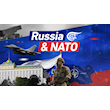More NATO won’t end the conflict
As long as NATO flirts with the idea of Ukraine’s entry into NATO, refuses to protest billions in counterproductive arms supplies, and agrees to militarize key corridors by force to irk Russia, its role in fueling the conflict stands virtually established.
-

More NATO won’t end the conflict
Days after Ukrainian President Volodymyr Zelensky said that his country was making an “accelerated” bid to join the North Atlantic Treaty Organization (NATO), it was met with some resistance. Several member states have already demonstrated divergence over any united front, laying bare the alliance’s deep internal divisions and why it is no guarantor of lasting peace.
For one, Bulgaria has been clear about its reluctance to support any such Ukraine prospect, and its refusal to sign a memorandum backing Ukraine is a telling sign that the current “security environment” is a transformative one. On the other hand, NATO member Slovenia has stayed its hand fearing any undue provocations that could push the Ukraine-Russia conflict deep into NATO territory. The mother of all ironies is that NATO’s own expansion has heightened the risk of future conflict towards the East. And so, by publicly diverging from its Central and Eastern European counterparts, Slovenia understands the costs of playing into Ukraine’s controversial membership and the appearance of coming across as an outlier on genuine peace. NATO would soon need an honest reckoning with reality: that its ambition to expand and beef-up defenses won’t end the protracted conflict.
First, the alliance’s top leaders continue to use Russia’s admission of territories as an excuse to cheer more military assistance, effectively ensuring continuity in a war that needs to meet a negotiated end. Washington hasn’t spared a moment to compromise Sweden’s so-called neutrality by engaging its marines in war scenarios, effectively challenging the appearance of peace as billions in arms are poured into Ukraine. Make no mistake: more of NATO’s implicit escalation around Russia won’t serve as a recipe for resolving the conflict. In fact, the alliance has played a leading role in pushing the conflict towards inevitability, when the option for negotiated peace was on the table, but put on the back burner.
Look back to the lead-up to Moscow’s special military operation: its legitimate security guarantees were communicated to Europe, but NATO made sure they fell on deaf ears. By passing on an opportunity against eastward expansion, NATO has shown that there is a separate standard of concern that is applied to Russia’s security guarantees and those of Ukraine. Rather than correcting that sense of neglect amidst protracted conflict, the bloc serves as a major party to incoming military aid. Similarly, stepped-up bloc defenses are designed to raise nothing but false alarms about an unavoidable threat to European security, when opportunities to de-escalate were given a hard pass.
NATO’s shortcomings on Russian security guarantees remain a fitting illustration of current strategic divisions. Pursuit for greater militarization in Europe has challenged the narrative that the alliance “is not” a party to the conflict. A dangerous cycle of territorial gains and losses in Ukraine is yet to prompt NATO chief Jens Stoltenberg to criticize weapon supplies which have heightened distrust between warring parties. The alliance’s escalating defense spending is also informed by the notion that Russia represents the greatest threat to Europe in modern memory. But at the same time, pressuring Sweden and Finland into relinquishing their wartime neutrality suggests it is an expanded NATO – not Russia – that serves as the principal source of instability to the East in the long term. Unlike the conflict that has drawn widespread international attention, a beefed-up NATO military alliance will constitute a threat that is there to stay.
Understand that the deliberate engagement of Swedish marines alongside U.S. forces is not just a matter of routine military exercises. It is tied to the assumption that NATO countries must encircle most of the Baltic Sea, as Pentagon officials actively invent wartime scenarios with Russia to justify military provocations. All this is a marked departure from NATO’s hollow rhetoric on regional peace, and its determination to ensure stability in an enduring manner. “Military nonalignment has served Sweden well, but our conclusion is that it won’t serve us equally well in the future,” said Swedish Prime Minister Magdalena Andersson at the time of her country’s pivot towards the alliance. Fast forward: allowing indivisible security to be compromised by NATO is barely a step in the right direction.
On refusing Ukraine’s NATO membership bid, one of the more divergent rationales from within the alliance includes that of Slovenia. It expressed fears that if NATO were to take a decision to admit Ukraine as a member, it could “be a clear declaration of the start of the war.” Glaring evidence from NATO’s involvement in endless wars – from Iraq to Afghanistan – confirms that the end goal is more destruction and nothing less. A bloc tendency to choose more aggression and less diplomacy have generated a trail of war crimes, lasting humanitarian destruction, and a rapid loss of peacemaking credibility in entire regions.
So as long as NATO flirts with the idea of Ukraine’s entry into NATO, refuses to protest billions in counterproductive arms supplies, and agrees to militarize key corridors by force to irk Russia, its role in fueling the conflict stands virtually established.

 Hannan Hussain
Hannan Hussain
 5 Min Read
5 Min Read












